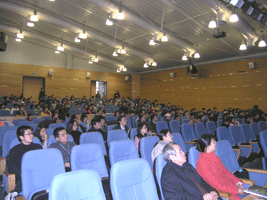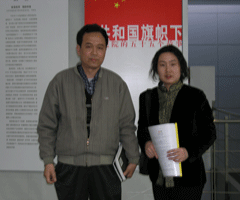
 |
||||||||||||||||||||||||||||||||||||||||||||||||||||
Introduction Designers Member list Sponsorship New Books Newsletter |
|||||||
| The 13th
dcb Design Forum Date:Mar.4,2005 Fri.2:30pm Place:The Auditorium Hall, 2nd Floor of Block E, BIAD, No.62, Rd. Nan Li Shi (300 meters north of Nan Li Shi Lu Subway station) |
|||||||
| The
topic:The creative and safty design |
|||||||
| Download the poster | |||||||
Booking &
Inquiry:010-64956392 13301369027 Teresa, Jennifer |
|||||||
The Admission Ticket:100
RMB |
|||||||
 |
 |
||||||
| 1 Left from the front:Mr.Zhou Qin Lin, General Architect of the Owner's committee of national theater | 2 Mr. Wei Jia. vice directer of Info Dep. of BIAD and secretary general of dcb Ms. Teresa Wu | ||||||
| A Glass
Bubble That’s Bringing Beijing to a Boil By JOSEPH KAHN New York Times, June 15, 2004 Some compare it to a globe severed at the Equator. To others it resembles a phosphorescent egg floating in a crystal sea. One prominent Beijing architect said that when the desert dust kicks up around Beijing, lathering the expansive glass dome in a pall of gray grime, it resembles nothing so much as dried dung. But the most apt analogy for the $300 million National Theater of China, now nearing completion in the political heart of Beijing, near Tiananmen Square, may be a hot potato. The building’s French architect, Paul Andreu, has come under investigation in France and intense scrutiny in China after a terminal he designed at Charles de Gaulle International Airport in Paris partly collapsed in May, killing four people, two of them Chinese. His troubles were taken as a green light for China’s state-controlled news media and a few leading architects to raise questions about the approval process, the safety standards and the aesthetic sensitivity of Mr. Andreu’s Beijing project, which is regarded as a favorite of China’s semi-retired senior leader, Jiang Zemin. Beijing’s cultural community is also complaining that less than 18 months before the titanium-and-glass complex is scheduled to open, there is no opening act lined up. In fact, no public or private group has agreed to operate the theater at all. China is treating the 2008 Olympics, to be held in Beijing, as an occasion to remake the capital. The government is razing old neighborhoods, laying hundreds of miles of roads and subway lines, and constructing monuments of modern architecture that the Communist Party hopes will stand as tributes to its leadership. But as billions of dollars of public money are spent on skyscrapers, stadiums and transportation facilities designed by two world’s leading architects, local designers are complaining that many of the projects are overpriced and out of touch with Chinese history. Even in a place where challenges to the leadership’s priorities are rarely permitted, voices of dissent are growing louder. “We are a poor country, not a fancy country, and we should not be wasting our money on monstrosities,” said Xiao Mo, an architectural-historian at Qinghua University in Beijing who has campaigned against the theater project. “I believe it is an insult to the people of China. “China is not alone in seeking to advertise its rising power through architecture. Societies on the rise, like the United States in the 1920’s and Japan in the 1980’s, often spend lavishly on new designs that critics consider too grand or iconoclastic. Yet the building boom here is in some ways unusual. Since 2000, floor space in China has doubled, according to Construction Ministry statistics. Some projects are public works and office complexes of such scale and cost that it seems unlikely they would be undertaken anywhere else. China also sets itself apart because it is still relatively poor, with an annual per capita income that surpassed $1,000 only last year. Its most ambitious projects are often financed with public money or by state-owned enterprises whose profits come from concessions bestowed by the government. And the architects chosen for the highest-profile projects are usually foreign. Two Swiss architects, Jacques Herzog and Pierre de Meuron, won the competition for Beijing’s main Olympic stadium. They designed a bowl of interwoven metal mesh that resembles a bird’s nest with a price ta8 of $543 million. The British architect Norman Foster is renovating Beijing s airport, using a dragon motif, in a project valued at $1.9 billion. Rem Koolhaas and Ole van Scheeren, Dutch architects, designed enormous new headquarters for China’s dominant state broadcaster, China Central Television, that has drawn almost as much scrutiny as Mr. Andreu’s National Theater. Mr. Koolhaas proposed building two 55-story Z-shaped towers angled toward each other. He told the Chinese state news media that his vision is a “hyperbuilding of unimaginable scale and complexity” intended to house all of the television station’s functions. The design won praise among some Chinese architects, but the price offended many others, with same critics arguing that the estimated cost of $730 million may be understated. Beijing is abuzz with speculation that the project may be scrapped as a symbol of the new leadership’s determination to cutback on excessive state investment and slow the overheated economy. Mr. Van Scheeren ans China Central Television official say that approval process is moving ahead and that the new building will be the base of China’s Olympic broadcasts. .”I know there’s been a lot of high level political discussion about how China should spend its money and the gap between rich and poor,” said Mr. van Scheeren. ”But I can assure you it is by no means dead.”. Wu Liangyong, a senior architect who has helped the government select designs for state-financed projects, has supported importing foreign talent to remake China’s cities. But he argues that the country has also squandered state assets on quirky notions of modern grandeur. “In my view, some Chinese cities have become experimental sites for novelty for novelty’s sake by some foreign masters,” he said. Reflecting the sensitivity, the Construction Ministry announced a new regulation this month requiring foreign architects to enter joint ventures with local architectural firms before taking on Chinese projects. Even before the Paris airport accident, Mr. Andreu’s National Theater 1 had become a flashpoint in the debate. The complex has one large 2,500-seat hall and three smaller auditoriums. They are arranged under a soaring glass dome, which is notable for having no central supporting columns. The dome is set like a floating bubble in a lake. The entrance is an underwater tunnel. Supporters say the design is stunning and luminescent, offering a welcome contrast to the Stalinist wedding-cake architecture of Tiananmen Square next door. Critics say it fails even to nod to Chinese tradition and violates every rule of feng shui, the traditional art of harmonizing people and their environment. Critics got a boost when a section of a new terminal Mr. Andreu designed at Charles de Gaulle airport collapsed last month. The accident prompted a flurry of criticism of Mr.Andreu’s design principles. The French news media also re-ported that French authorities were investigating whether the Paris air-port, Mr. Andreu’s employer, paid bribes to win the Beijing theater contract. Mr. Andreu, who was not available for comment, has also built the new Shanghai airport, a stadium in Guangzhou and the Shanghai Opera House, making him one of the most prolific foreign architects in China. “We have confidence in Paul Andreu,” said Wang Zhengming, spokesman for the committee over-seeing construction of the theater. “The accident in Paris will have no effect on our building.” Mr. Wang also denied any corruption. But Mr. Xiao Of Qinghua University, who compared the theater to dried dung, is one of several dozen critics who have lobbied against the project even after it won final Politburo approval in 2001. He and other opponents have begun a fresh campaign to have it demolished. Beyond aesthetic issues, opponents say it will prove impossible to run efficiently. The central dome needs to be illuminated and air-conditioned even if only the smallest of its performance centers is in use. They say the underwater entrance poses an unacceptable safety risk in the event of fire, earthquake or terrorist attack. At least partly for this reason, critics say, the theater has become an orphan, with no agency willing to run it. With potentially enormous maintenance expenses, neither the Culture Ministry nor the Beijing city government, much less smaller theater groups, want to accept the responsibility, according to Wu Zuqiang, a member of the Chinese People’s Political Consultative Congress, an advisory body to the central government. “We’ve got this amazing piece of hardware in place but no one thought about the software,” Mr. Wu said.”You need to book first-rate international acts two or three years in advance.” Unless the government acts quickly, Mr. Wu said, “We are going to raise the curtain on an empty house.. |
|||||||
| More details about the FORUM:http://www.fancy-design.com/dcb/2004forum.htm | |||||||
Design Collaboration,Beijing All rights reserved No.100101-200 P.O.Box, Beijing 100101 P.R.CHINA Phone: +86-10-64956392 teresa_wu_cn@yahoo.com |